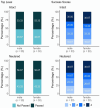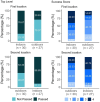Success in the Natural Detection Task is influenced by only a few factors generally believed to affect dogs' olfactory performance
- PMID: 38811746
- PMCID: PMC11137087
- DOI: 10.1038/s41598-024-62957-5
Success in the Natural Detection Task is influenced by only a few factors generally believed to affect dogs' olfactory performance
Abstract
Research into dogs' olfactory ability is growing rapidly. However, generalising based on scientific results is challenging, because research has been typically conducted on a few specially trained subjects of a few breeds tested in different environmental conditions. We investigated the effects of temperature and humidity (outdoors), age, test location, sex, neutering status, and repeated testing (outdoors and indoors) on the olfactory performance of untrained family dogs (N = 411) of various breeds. We employed the Natural Detection Task with three difficulty levels, from which we derived two performance metrics: Top Level and Success Score. Temperature (0-25 °C) and humidity (18-90%) did not affect olfactory performance. Young adult dogs surpassed other age groups in reaching the Top Level. Sex and neutering status showed no discernible influence on Top Level and Success Score. Dogs performed better in both metrics when tested indoors compared to outdoors. In the test-retest procedure no significant learning effect was observed. We confirmed on untrained companion dogs that olfactory performance declines with age and rejected some factors that have been previously hypothesised to significantly affect dogs' olfactory success. The influence of the testing environment was notable, emphasising the need to consider various factors in understanding dogs' olfactory capabilities.
Keywords: Age; Bayesian statistics; Dog; Natural Detection Task; Olfaction; Test location.
© 2024. The Author(s).
Conflict of interest statement
The authors declare no competing interests.
Figures






Similar articles
-
Breed differences in olfactory performance of dogs.Sci Rep. 2025 Jan 21;15(1):2675. doi: 10.1038/s41598-025-87136-y. Sci Rep. 2025. PMID: 39838112 Free PMC article.
-
Scent of the familiar: an fMRI study of canine brain responses to familiar and unfamiliar human and dog odors.Behav Processes. 2015 Jan;110:37-46. doi: 10.1016/j.beproc.2014.02.011. Epub 2014 Mar 6. Behav Processes. 2015. PMID: 24607363
-
Investigating individual learning behaviour of dogs during a yes/no detection task.Behav Processes. 2024 Apr;217:105030. doi: 10.1016/j.beproc.2024.105030. Epub 2024 Apr 16. Behav Processes. 2024. PMID: 38636131
-
Olfaction in the canine cognitive and emotional processes: From behavioral and neural viewpoints to measurement possibilities.Neurosci Biobehav Rev. 2024 Feb;157:105527. doi: 10.1016/j.neubiorev.2023.105527. Epub 2023 Dec 29. Neurosci Biobehav Rev. 2024. PMID: 38160722 Review.
-
Agility and search and rescue training differently affects pet dogs' behaviour in socio-cognitive tasks.Behav Processes. 2009 Jul;81(3):416-22. doi: 10.1016/j.beproc.2009.03.015. Behav Processes. 2009. PMID: 19520242 Review.
Cited by
-
Canine olfactory detection of florfenicol residues in goat milk: a pilot study.Front Vet Sci. 2025 Jul 21;12:1579933. doi: 10.3389/fvets.2025.1579933. eCollection 2025. Front Vet Sci. 2025. PMID: 40761840 Free PMC article.
-
Breed differences in olfactory performance of dogs.Sci Rep. 2025 Jan 21;15(1):2675. doi: 10.1038/s41598-025-87136-y. Sci Rep. 2025. PMID: 39838112 Free PMC article.
-
Exploring canine's olfactive threshold in artificial urine for medical detection.PLoS One. 2025 May 2;20(5):e0321394. doi: 10.1371/journal.pone.0321394. eCollection 2025. PLoS One. 2025. PMID: 40315287 Free PMC article.
References
-
- Wasilewski T, Gębicki J, Kamysz W. Bio-inspired approaches for explosives detection. Trends Anal. Chem. 2021;142:116330. doi: 10.1016/j.trac.2021.116330. - DOI
MeSH terms
Grants and funding
LinkOut - more resources
Full Text Sources

